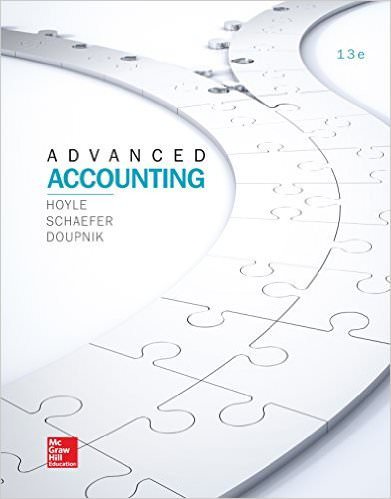Test Bank For Advanced Accounting Joe Ben Hoyle 13e
Digital item No Waiting Time Instant DownloadISBN-13: 978-1259444951 ISBN-10: 1259444953
In Stock
Original price was: $55.00.$28.00Current price is: $28.00.
Test Bank For Advanced Accounting Joe Ben Hoyle 13e
File: Chapter 03 – Consolidations – Subsequent to the Date of Acquisition
Multiple Choice:
[QUESTION]
1. Which one of the following accounts would not appear in the consolidated financial statements at the end of the first fiscal period of the combination?
A) Goodwill.
B) Equipment.
C) Investment in Subsidiary.
D) Common Stock.
E) Additional Paid-In Capital.
Answer: C
Learning Objective: 03-01
Topic: Consolidation―Overall effects
Difficulty: 2 Medium
Blooms: Understand
AACSB: Reflective Thinking
AICPA BB: Critical Thinking
AICPA FN: Measurement
[QUESTION]
2. Which of the following internal record-keeping methods can a parent choose to account for a subsidiary acquired in a business combination?
A) Initial value or book value.
B) Initial value, lower-of-cost-or-market-value, or equity.
C) Initial value, equity, or partial equity.
D) Initial value, equity, or book value.
E) Initial value, lower-of-cost-or-market-value, or partial equity.
Answer: C
Learning Objective: 03-02
Topic: Investment methods―Identify and differentiate
Difficulty: 1 Easy
Blooms: Remember
AACSB: Reflective Thinking
AICPA BB: Critical Thinking
AICPA FN: Measurement
[QUESTION]
3. Which one of the following varies between the equity, initial value, and partial equity methods of accounting for an investment?
A) The amount of consolidated net income.
B) Total assets on the consolidated balance sheet.
C) Total liabilities on the consolidated balance sheet.
D) The balance in the investment account on the parent’s books.
E) The amount of consolidated cost of goods sold.
Answer: D
Learning Objective: 03-02
Topic: Investment methods―Identify and differentiate
Difficulty: 2 Medium
Blooms: Understand
AACSB: Reflective Thinking
AICPA BB: Critical Thinking
AICPA FN: Measurement
[QUESTION]
4. Under the partial equity method, the parent recognizes income when
A) Dividends are received from the investee.
B) Dividends are declared by the investee.
C) The related expense has been incurred.
D) The related contract is signed by the subsidiary.
E) It is earned by the subsidiary.
Answer: E
Learning Objective: 03-02
Learning Objective: 03-03c
Topic: Investment methods―Identify and differentiate
Topic: Investment and income―Partial equity method
Difficulty: 1 Easy
Blooms: Remember
AACSB: Reflective Thinking
AICPA BB: Critical Thinking
AICPA FN: Measurement
[QUESTION]
5. An impairment model is used
A) To assess whether asset write-downs are appropriate for indefinite-lived assets.
B) To calculate the fair value of intangible assets.
C) To calculate the amortization of indefinite-lived assets over their useful lives.
D) To determine whether the fair value of assets should be recognized.
E) To determine the likelihood that the fair value of an assumed liability will increase.
Answer: A
Learning Objective: 03-05
Learning Objective: 03-07
Topic: Impairment―Goodwill―Rationale
Topic: Impairment―Intangibles other than goodwill
Difficulty: 2 Medium
Blooms: Remember
AACSB: Reflective Thinking
AICPA BB: Critical Thinking
AICPA FN: Measurement


Reviews
There are no reviews yet.